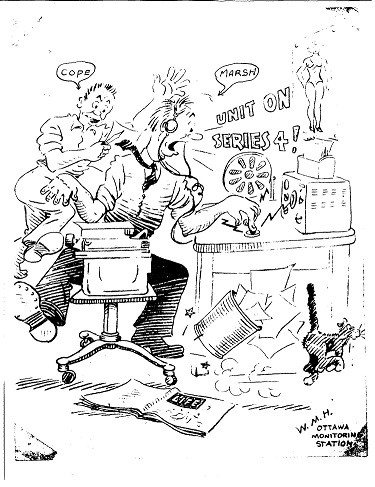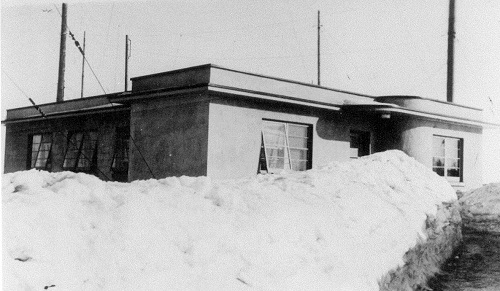|
But where did all the operators come
from?
In his book A Man Called Intrepid, William Stephenson recounts
the activities of Canadian William Stephenson during World War II (Camp X etc.), where operators work at various interception
stations:
"Stephenson, who had never forgotten his schoolboy exchanges
with the Morse operators on Great Lakes freighters, regarded seagoing
radiomen as among the world's best. They were accustomed to discomfort and
to working in close quarters alone. They could hang onto the faint signals
of a moving station surrounded by the clutter of other transmissions
drifting across the wave bands. At sea, they had to recognize quickly the
'fist' of the particular operator they might seek, detecting subtle
characteristics in the way he worked his key that amounted to an
individual signature." (A Man Called
Intrepid, 1976, by William Stevenson, Harcourt Brace
Jovanovich, chapter 7, pp. 50-51)
This is where many, if not the majority of operators and inspectors who
monitored and then managed the frequency spectrum, came from for many
years.

The Ottawa monitoring station during
the last war
Lloyd Cope recounts:
"In the spring of 1941, Ed Davey, Charley Rose and Gerry Gard were
responsible for the frequency standard and VAA, the master station for
the Branch's network, and also for a few intercepts at the old site near
the barn on the Experimental Farm. We were quite surprised to follow
very interesting communications about the battle to sink the Bismark, a
German ship.
During this time, Wilbur Smith, the chief standards engineer at
Transport and his boss J.W. Bain worked actively on the plans they had
proposed in conjunction with the people from the Royal Canadian Navy to
build a new station half a mile away on Merivale Road. The station began
operating in the fall of 1941 and from then until January 1942, new
operators continued to arrive to help with the interception
work.
During the same period, I and several other operators from Ottawa
were trained in direction finding at the Department's direction finding
station at St. Hubert on Montreal's south shore. This DF station had
originally been set up by the Department of Transport to provide air
control for aircraft en route over the ocean to Europe.
The Ottawa station was equipped with National HRO receivers,
Belini-Tosi style direction- finding equipment and each operating
position had its own intercom. Two technicians, René Arial and Dan
Maclean ensured that the equipment operated properly.
Around 1942, another room was added to the station that was large
enough to accommodate all the shifts, or 125 operators (both
male and female). One end of the building contained the teletype
linked directly to the Royal Canadian Navy (RCN) and the operator of
this equipment alternated with the operator of the DF equipment. A
position was also reserved for listening to announcements from Berlin,
where the names of Canadians who had been taken as prisoners of war in
Germany were copied down. We passed the information on to the RCN on
16-inch records. Later on, we did the same thing with the bulletins
issued by Tokyo, but the transmissions were of very poor
quality.
There was also a position for listening to Canadian transmissions
to monitor the "bad guys" (to ensure there were no
security breaches in Canadian communications). We intercepted a
transmission on that station that we thought was clandestine, but in the
end it turned out to be a network of seminarians located close to the
Beechwood Cemetery in east Ottawa.
The VAA station occupied a small room at the monitoring station in
Ottawa. Near the end of the war, this position was in the teletype room
with the one reserved for recording the names of Canadians who had been
taken prisoner and the one for monitoring domestic stations.
Each operator used one HRO receiver. Most of the time, no specific
task was assigned, with each person looking for messages from surfaced
submarines on any frequency. With a group of 25 operators (per shift), it did not take long before this constant
sweep through the bands revealed a few frequencies being used by a
number of submarines. Three of the frequencies referenced the call signs
RXU (French station in Pétain), MMA and KYU (Bismark).
A key aspect of this interception work was that the Germans were
very methodical in everything they did. If they had used a frequency
once, they would use it again for subsequent transmissions. The
transmitters used had a very musical-like sound, which helped to
identify them on the band. Sometimes, particular operators could even be
identified by their "fist" title (by the way they handled
the key and transmitted the Morse code characters).
Because each submarine had to surface to transmit its message, the
transmissions were very short and usually resembled something like "WW
ABCD EFGH. HI". In just a few seconds, the message was copied down,
while someone called out the frequency to the RD operator. Believe it or
not, good bearings were frequent and the information was immediately
forwarded by teletype to the RCN and then to the Royal Navy that
co-ordinated all the bearings from around the Atlantic. Near the end of
the war, bearings were obtained using a cathode ray tube
display.
I remember a particular intercept around 1943. One of the
operators, Ross Stephens, almost fell off his chair when he received a
very powerful signal that could be clearly heard in the room. He
notified the DF operator and the reading showed a line to the east of
Ottawa. From subsequent information, we realized that the submarine was
in the St. Lawrence River near Quebec City.
Several times during the winter months, we were surprised to
receive transmissions from western Europe, the Baltic Sea, and so forth,
to learn that they were due to an abnormal propagation effect call the
"long skip". (The skip is the distance between
propagation hops between the sky and the earth. A long skip occurs when
the ionized layer is very high.)
The intercepts were primarily in the 6 and 7 megahertz bands, and
the ones from the stations on the Baltic Sea and the North Sea were in
the 3 megahertz band. Most of the submarine transmissions were
intercepted in the evening.
A curious event was recorded one evening when an operator
intercepted a message from a hospital ship on the coast of Africa. He
remembered intercepting a message the previous evening from the same
station with the same "fist" transmitting a message similar to the
submarine messages. The Navy was informed about it.
Around 1944, a red telephone was installed at the shift
supervisor's desk. This telephone was connected directly to Prime
Minister Mackenzie King's residence to notify him immediately of the
invasion of Africa, and then of the landing in Europe. The message was
to be sent by the BBC once all transmissions had been shut down as
agreed earlier. The transmissions grew quiet and we all held our breath
as we waited (June 6, 1944). The
announcer broadcast the two invasions. I was on duty when the news came
in, around 2 a.m., and I woke the Prime Minister to tell him. He merely
said thank you!
The 125 operators received a monthly bonus of $20 from the Navy; I
suppose it was to make up for keeping quiet and putting up with the
question "Why aren't you in uniform?"
During those years, the Army also operated a monitoring station at
Leitrim and the Navy was installed not far from the Department of
Transport station at the Experimental Farm. The Navy's station was used
for interception and their own communications. Furter, some operators
could also be assigned to specific tasks.Bill Ryan said that when he
arrived in Ottawa, his job was to monitor transmissions from the French
station at Vichy (RXU), which he had already been
doing at the Forrest Centre.
In John Bryden's book, "Best-Kept Secret, Canadian Secret
Intelligence in the Second World War", Lester Publishing, a revealing
text:
 "Everything
depended on the quality of equipment, the personnel and speed. U-boat
messages were notoriously brief - as little as twenty-two seconds. An
operator might spend hours hunched over his radio set, his head clamped
in padded earphones, ears numbed by an incessant hiss. Then suddenly the
static would leap to life in staccato of Morse code. The man's hand
would slam onto a buzzer and an assistant would jump to the teletype
machine, banging the frequency numbers out on the keys. Within a couple
of seconds, the person in Bermuda would begin his (D.F.)
search." "Everything
depended on the quality of equipment, the personnel and speed. U-boat
messages were notoriously brief - as little as twenty-two seconds. An
operator might spend hours hunched over his radio set, his head clamped
in padded earphones, ears numbed by an incessant hiss. Then suddenly the
static would leap to life in staccato of Morse code. The man's hand
would slam onto a buzzer and an assistant would jump to the teletype
machine, banging the frequency numbers out on the keys. Within a couple
of seconds, the person in Bermuda would begin his (D.F.)
search."
Ernie Brown was responsible for monitoring a relatively busy
frequency, which made his work more interesting.
Ernie recounts:
"The operators were all monitoring the German coast stations and
the other stations in occupied Europe. They copied all the messages in
Morse code.
When a signal with a different modulation was sent and a manual
transmission was heard, it could only mean a mobile station or a
submarine, or a "raider" (a German warship). The message was always very
short, often in a single coded group of five letters. You had to be
quick to notify the DF operator who had to memorize the frequencies,
tune to the proper one and take the reading. He often had time for no
more than one adjustment.
I was lucky to have been assigned to monitor a very busy station,
because the work was very boring otherwise."
Around 1943, some operators monitored German transmissions, while
others monitored the Italian ones. When the war ended in Europe, it was no
longer necessary to monitor submarine transmissions. Some of the operators
had been trained in "Katakana" code (76 characters)
and were transferred to Vancouver on October 23, 1943, to monitor the
Japanese transmissions."
Still at the farm house, HRO receivers were everywhere, in the living
room, in the dining room, in the hallways and bedrooms, and operators
everywhere... The staff moved to the new station on Merivale Road in 1942.
(Del Hansen)

The Ottawa
monitoring station in 1942.
|







 "Everything
depended on the quality of equipment, the personnel and speed. U-boat
messages were notoriously brief - as little as twenty-two seconds. An
operator might spend hours hunched over his radio set, his head clamped
in padded earphones, ears numbed by an incessant hiss. Then suddenly the
static would leap to life in staccato of Morse code. The man's hand
would slam onto a buzzer and an assistant would jump to the teletype
machine, banging the frequency numbers out on the keys. Within a couple
of seconds, the person in Bermuda would begin his (D.F.)
search."
"Everything
depended on the quality of equipment, the personnel and speed. U-boat
messages were notoriously brief - as little as twenty-two seconds. An
operator might spend hours hunched over his radio set, his head clamped
in padded earphones, ears numbed by an incessant hiss. Then suddenly the
static would leap to life in staccato of Morse code. The man's hand
would slam onto a buzzer and an assistant would jump to the teletype
machine, banging the frequency numbers out on the keys. Within a couple
of seconds, the person in Bermuda would begin his (D.F.)
search."